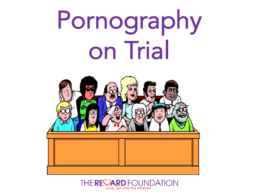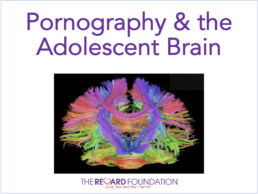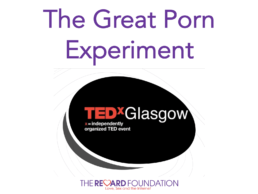Lesson Plans: Internet Pornography
A unique feature of The Reward Foundation lessons is the focus on the workings of the adolescent brain. This best helps pupils understand and build resilience to potential harms from pornography use. The Reward Foundation has been accredited by the Royal College of General Practitioners in London to teach professional workshops on pornography’s impact on mental and physical health.
Our lessons comply with the latest Department of Education’s (UK government) “Relationships Education, Relationships and Sex Education (RSE) and Health Education” statutory guidance. The Scottish Editions align with the Curriculum for Excellence.
Lesson plans: Internet pornography can be used as stand-alone lessons or delivered in a group of three or four. Each lesson has PowerPoint slides plus a Teacher’s Guide and, where appropriate, packs and workbook. The lessons come with embedded videos, hot-links to key research and other resources for further enquiry to make the units accessible, practical and as self-contained as possible.
- Pornography on Trial
- Love, Pornography & Relationships
- Internet Pornography and Mental Health
- Pornography and the Adolescent Brain
- The Great Porn Experiment
We’d love your feedback so that we can improve them.
If the lessons are useful to you, feel free to make a donation to our charity. See the DONATE button in the footer below.
Lesson 1: Pornography on Trial
Internet pornography is widely used by children and young people, mainly by boys, but now increasingly by girls.
In this lesson for upper school pupils we put pornography on trial. We ask the question, “Is pornography harmful?” We offer 8 pieces of evidence to help pupils think through the issues, critique the evidence like a jury, and write up their verdict with their reasoning set out. They’ll hear from a neurosurgeon, from a young man and a young woman who are recovering porn addicts, from a psychologist in the pay of the porn industry, from an ‘ethical’ porn producer, and see the World Health Organization’s definition of sexual health.
As background, the World Health Organization’s International Classification of Diseases (ICD-11) states that problematic pornography use can be diagnosed as a compulsive sexual behaviour disorder and as an addictive disorder.
In the 1950s and 60s the Tobacco Industry paid healthcare professionals to deny there was any link between smoking and lung cancer. Today the multi billion dollar porn industry also uses psychologists to do the same and to deny the evidence from medical and social science research about the risks and harms. These industry pundits operate widely on social media and on the internet in general. This leads to a lot of confusion about the actual impact of internet pornography especially on adolescents.
We’d love your feedback on the lessons so that we can improve them.
If the lessons are useful to you, feel free to make a donation to our charity. See the DONATE button in the footer below.
Lesson 2: Love, Pornography & Relationships
How does a person recognise the characteristics and positive aspects of healthy one-to-one intimate relationships?
What impact does a pornography habit have on sexual consent, sexual pressure, coercion, rape, sexual assault and friendship? What are the risks and rewards of pornography use? And what are the signs and symptoms of overuse?
The lesson provides a range of strategies to help pupils be all they can be and to develop healthy relationships going forward.
We’d love your feedback so that we can improve the lessons.
If the lessons are useful to you, feel free to make a donation to our charity. See the DONATE button in the footer below.
Lesson 3: Internet Pornography and Mental Health
In the past few years there has been a staggering rise in mental health issues amongst young people.
The lesson looks at body confidence and how pornography sites and social media can cause obsessive comparison with others online. It looks too at how internet companies, especially pornography and gaming companies, target vulnerabilities in the adolescent brain to make them habitual users.
Pupils discover that free sites are not really free. Internet companies make billions of dollars/pounds from a user’s attention, the sale of their personal data and preferences for advertising purposes, pages downloaded and sale of related products.
This lesson is aimed at upper school pupils but may be adapted for the lower school. The aim is to enable pupils to recognise what is normal and what is an issue in themselves and others and, when issues arise, know how to seek support as early as possible from appropriate sources.
It offers useful strategies for reducing internet use and for building resilience.
We’d love your feedback so that we can improve the lessons.
If the lessons are useful to you, feel free to make a donation to our charity. See the DONATE button in the footer below.
Lesson 4: Pornography and the Adolescent Brain
This lesson looks at the fantastic, plastic adolescent brain. It explains why neuroscientists say , “Of all the activities on the internet, porn has the most potential to become addictive”. How does it influence sexting?
Pupils learn about how internet activities like porn, social media, gaming, gambling etc. are ‘supernormal stimuli’ that can feel more exciting than anything else.
How much porn is too much? What mental and physical health issues might it cause? What effect does it have on attainment or relationships?
Pupils learn about how the brain can learn to exercise self control, to self regulate and what strategies help to achieve that. They find out about resources to help them be well-informed and be able to make positive choices.
We’d love your feedback so that we can improve the lessons.
If the lessons are useful to you, feel free to make a donation to our charity. See the DONATE button in the footer below.
Lesson 5: The Great Porn Experiment
This lesson updates the facts and statistics from the extremely popular TEDx talk, ‘The Great Porn Experiment’ from 2012. So far the talk has had over 15 million views and been translated into 20 languages.
It explains the risks of overindulging in internet porn over time, such as porn-induced erectile or arousal dysfunction, and why adolescents take longer to recover their sexual health than older men.
The lesson offers good news with several recovery stories by young people who feel healthier, more energetic, more entrepreneurial and harder working and more successful in attracting mates once they quit porn.
There are helpful resources too to inform pupils should they wish more information.
We’d love your feedback so that we can improve the lessons.
If the lessons are useful to you, feel free to make a donation to our charity. See the DONATE button in the footer below.






